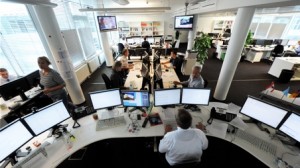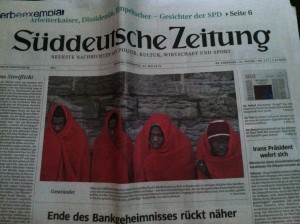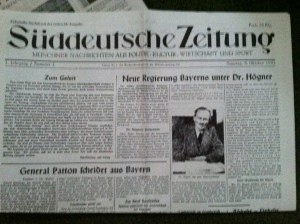Chief photographer of the Deutsche Presse-Agentur Michael Kappeler believes taking one good photograph is all you need to market news photos.
“Before in the print world, we tried [to get] one good photo which tells the whole story, but now that’s changing,” said Kappeler.
Today in the digital world, photographers are able to tell stories in countless photographs. However, this is not how DPA conducts its business.
“Print is still important,” said Kappeler.
A surprising statement from a modern newsperson, but in his opinion, it’s a justifiable one.
“It’s the moneymaker for us because we cannot earn money in the digital world,” said Kappeler. “So we make money with the print clients and so we have to satisfy them.”
Deutsche Presse-Agentur GmbH, founded in 1949 in Germany and based in Hamburg, has grown to be a major worldwide operation serving print media, radio, television, online, mobile phones, and national news agencies. News is available in German, English, Spanish and Arabic. The English service is produced in Berlin, which is also the location of the central news office. The DPA has offices in 80 countries, 12 regional German bureaus along with 50 additional offices in Germany. Point Park students and faculty visited the Berlin office and also heard from Christian Rowenkamp, head of corporate communication, on DPA operations.
In particular, DPA aims to please clients with its “classic” news photographs. That is, one photo that shows the action and emotion of a situation, and tells the story with one exposure of the camera sensor. Kapperler said the agency has 100 photographers in Germany alone to accomplish that compared to the eight the Associated Press has in all of Germany.
By using the word “client,” Kappeler is of course referring to media outlets. Not the public. This in opposition to its American counterpart, AP, who caters to its news partners but also permits some public access to its website, stories and photographs. .
“We are only providing news to business clients,” said Kappeler. “They can use these pictures or information to bring to their clients because we have no way to earn money back [from non-business clients]. So they can [sell] news to their clients, so they can buy the news.”
The DPA’s international reach and commitment to its German clients make it vital to reporting German news. Its client list proves it. Nearly 100 percent of German media outlets are partners of DPA, according to Kappeler.
“For…the Olympics, or the pope’s election… we send our own DPA photographers to countries where these things happen,” said Kappeler. These photographers have two jobs – “They do general news, but they also follow the German interest.”
 A hard concept to understand for Americans, as the United States is often at the center of attention when it is involved in global affairs. For smaller countries like Germany, an extra effort is required to report international news.
A hard concept to understand for Americans, as the United States is often at the center of attention when it is involved in global affairs. For smaller countries like Germany, an extra effort is required to report international news.
“If something happens, there is not always a German interest [reported by other outlets],” said Kappeler. “The best example is the Olympics. If a German sports team reaches fourth place, nobody will take a picture of them because [reporters] just follow the medal winners.”
One DPA German photograph of interest worldwide was the recent one that Kappeler himself took – of outgoing Pope Benedict’s hand with the papal ring about to be destroyed per Catholic Church regulations. He said he took a chance on that photograph, but it was used in countless publications.
Thus, DPA’s commitment to its clients leads them to exactly what they need.
“It’s our task, then, just to follow the German interest because there is a huge media market in Germany, so we have a lot of clients and they want to know what the Germans are doing.”


